|
Posted by Romy the Cat on
08-08-2007
|
The first draft
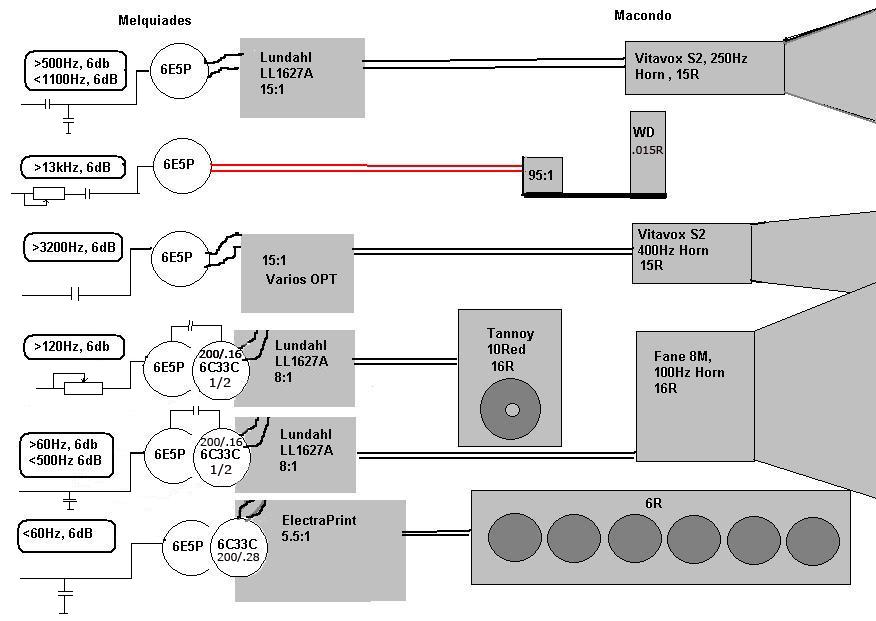
|
|
|
|
Posted by Romy the Cat on
08-18-2007
|
|
Spent quite a few hours trying to rebuild the Super Milq new power supplies. Faced bunch of the problems and recognized that the entire ceremony of converting off my Super Milq intro 6 or 7 channels amp we'll be much-much more painful then I initially expected. Anyhow the first part is done and the new power supplies and all necessary voltages is ready to go. It will be some a more changes in PS but they will be very minor and have no affect the architecture of the entire power supply.
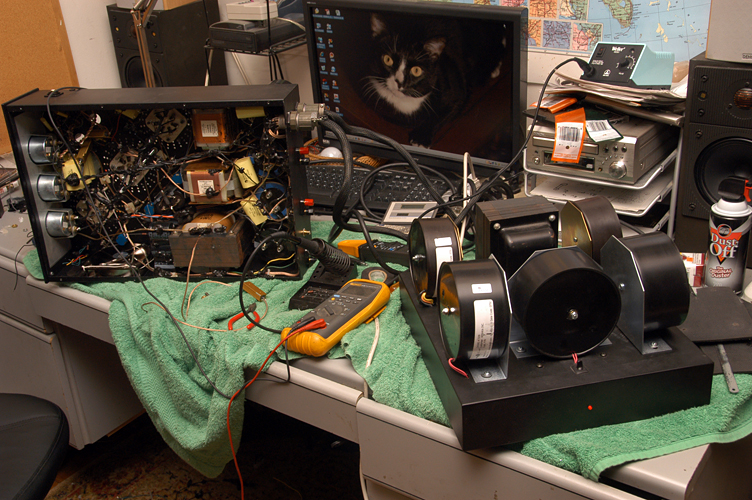
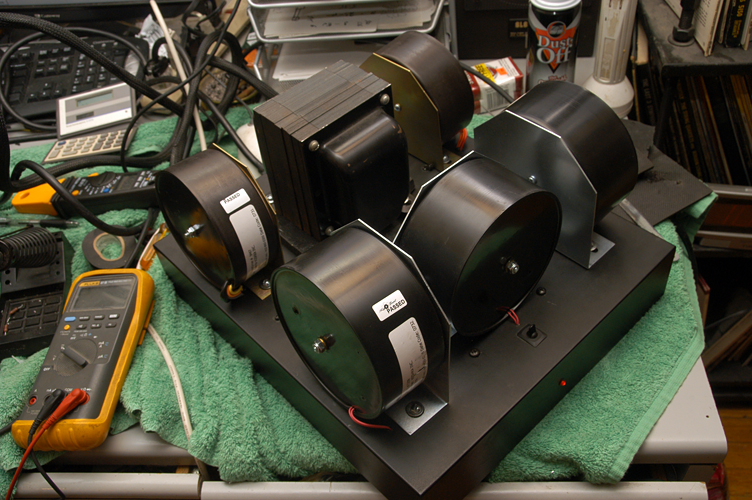
Everything looks like the resolved on power supply level, however one consideration is still pending. At this point I did not decide if I go for one transformer-source for single-stage and double-stage amplifiers or if I will use separate transformers and separate rectifiers (case A or B) The way how the entire amp is architected I can literally change it on fly within a few minutes, there are however some cons and pros in both cases…
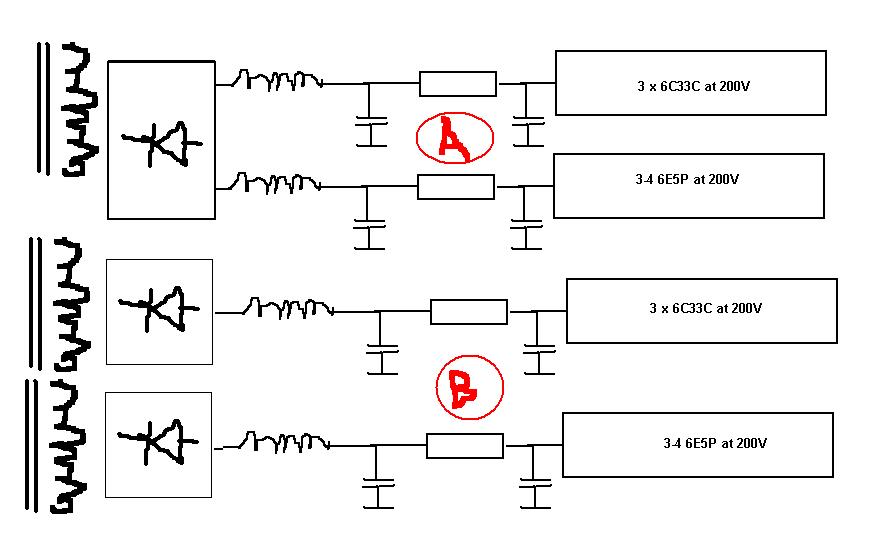
PS: While was screwing with Milq I was listening new interesting pieces” the Felix Weingartner’s Symphonies #2, #3, #4. It is not great mucks but it is good music. I with it would be played by Vienna or Prague orchestras – that time of the musk need a very high luxuryty sound…
|
|
|
|
Posted by Romy the Cat on
08-20-2007
|
|
Ok, I completely disassembled one of the Super Milqs and physically injected extra 3 channels. It looks like everything is all right real-estate wise, still I would prefer of course to have more space….
As now the amp is completely shattered as it used to be. Now it is time to repackage everything, connect everything, put other transformers in play, to rearrange biasing, rebuild filters and do many other things… BTW, I have chosen to go for driving the single-stages and double-stages from one transformer/rectifier but from different LCRC filters…. Here is my first raw draft of the new Super Milq input filters. This draft does not reduces the quantity of the resistors yet and does not combine the biasing resistors with actuators and filters. It does not look so bad at all if I go for 6dB high-pass filter at Fundamental channels. I still have a feeling that I might reconsider it eventually and go for 12dB…., will see how it will be work out…

|
|
|
|
Posted by Romy the Cat on
08-21-2007
|
|
Here is the next more accurate and less abstract version of the new amps input section. The different functioning resistors are not equated to a common denominator bit it is how it will be build initially, during the calibration and testing and I do not know exactly how mach I would need to attenuate the channels.
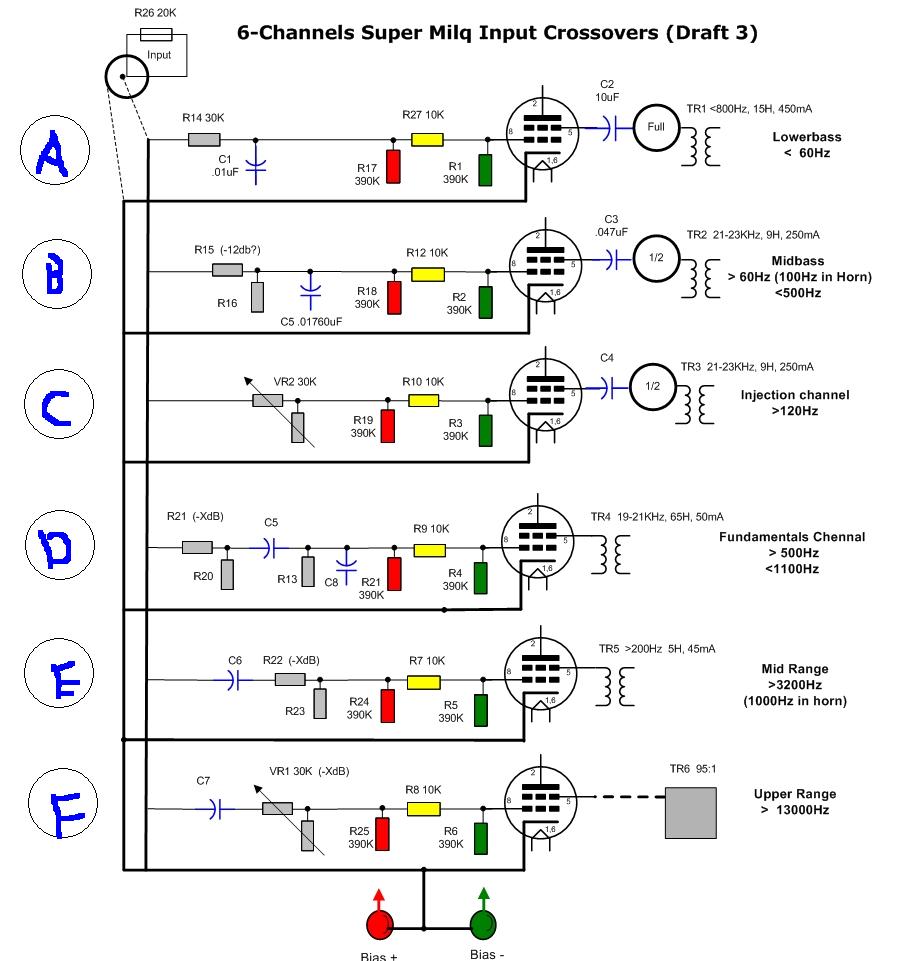
I do not see any problem in this design besides that the filter in the HF channel is loaded against a 24-stap stepped attenuator (1dB per step). The attenuator is 30K but sine it is constant impedance laden-type it has with each step two pair of resistors switching. So, the realty it does not maintain flat 30K but fluctuates with each step from 29.96K to 3.01K. This would bring a very-very minute drifting of crossover point and consequential sliding of time-alignment in the tweeter. I acknowledge that it will be VERY small, perhaps negligibly small - only theoretical, but I do not know at this point if it will be auditable. If it will be then I would move the attenuator on the left and load the filter to a fix divider.
|
|
|
|
Posted by Romy the Cat on
08-28-2007
|
|
Contemplating now how to organize biasing for 3 singe stages of my 6-chanls amp I was faced the dilemma: do I need to bias my tubes. The 6E5P/6E6P are Russian tubes and it means that are very different right from the boxes. The Milq, driver tubes, being loaded into low impedance the OPT’s primary will fluctuate current. It was not critical in the two stages design what it affect nothing but in the single-stage it is more critical. The single-stage will run:
1) S2 Fundamental Channel - 6E5P
2) S2 Midrange Channel - 6E6P
3) WaterDrop Tweeter Channel - 6E6P
From one side those channels case less about power and damping but I ma concern that with different current I will have different gain, not to mention the opportunity to overheat the best tubes. The way how the amp will be organized the single-stage channels will have real-time current monitoring and also I will have a chance to use pick the best tubes for a given channels, placing the “unacceptable” for single-stage channels to the two-stage channels. From another side it would be nice juts to have an adjustable bias to set a default current for the stages. The problem is that I would like to do it as good as I can and I do not relay want to screw with negative bias voltage. The voltage goes right to the grid and it is very-very sensitive voltage. I presume that passing it over an attenuator might be an issue…
Then what to use. I use 3500 Bourns and are 2W and do fine in out stage. For the input sage of the new Super Milq I would need 4 of them – a lot of necessary real-estate that would make the negative paths too long. The miniature 10 turns 1.5V wirewound are $141 each –
http://www.etisystems.com/mw10.asp
... a little painful and I do not know how they sound. To use trimpots is problematic as well. The Vishay Bulk Metal Foil trimmers:
http://www.goodsoundclub.com/pdf/VishayBulkMetalFoil_1280G.pdf
and the similar: http://www.vishay.com/resistors-variable/trimmers/bulk-metal-foil/
are wonderful but they are very ugly to use and in BL version (panel mounted) and they are $38 and still have just 20K range but no to mention 9 week of thelead time…. To put there regular cement tripod is not something that I would like to do, though Dima insists that it should not be a big deal since the trimpots will be hidden behind the caps and a large 390K biasing resistor… Still they are the bias of the HF channels… and I presume that a fixed good quality resistor will do anyhow better job then anything else…
Manville I did some measurements what a single stage dose with fixed-fixed bias at 190V
Bias -4V 6E5P
1. 34mA
2. 29mA
3. 17mA
4. 26mA
5. 22mA
6. 24mA
7. 24mA
8. 21mA
Bias -4V 6E6P-DR
1. 32mA
2. 35mA
3. 25mA
4. 30mA
5. 28mA
6. 20mA
7. 17mA
8. 40mA
It does not look as it will be useable without bias regulation… :-) I just need to find a “fine way” to adjust that R10 resistor… Rgs, Romy the Cat
|
|
|
|
Posted by Romy the Cat on
08-31-2007
|
|
Another decision that I need to make about the new Super Milq. I have MF and Fundamental Channels around the Vitavox S2 drivers that will be driven directly from the single-stage amplifiers, with the crossovers and attenuators sitting at amplifier line-level. This lives the S2 driver too vulnerable. I care less about the stress during music playing - with the limited power of 6E5P it will be saved. I also do not care about the start-up current - it climes to the cruse current very gently. My concern is about the DC component. I am known to be very liberal with the way how I use amps: I plug the inputs with amp on and do some other violent actions. Should I be worry?
I have at 2 Vitavox channels ("D" and "E" channels at the image above) the attenuators that I might very much put after the channels’ output transformers before the driver. Since the channels are HF and since they care little power it will be no negative consequences to Sound but the S2 driver will have a minor layer of protection (attenuation). From another perspective the killing some grid currents in HF tubes will keep my low inductance HF output transformers further from LF saturation…. So, go figure what would be the most rational solution.…. The caT
|
|
|
|
Posted by Paul S on
08-31-2007
|
Romy, I am not clear why you would worry about DC if you can set the RC where you want it and mute input.
Biggest problem, of course, is HF, since it takes bugger all to blow those ribbons. But I thought you had that variac that the Serb gave you?
As for attenuation, I know that John Chapman offered a modular pre that allows as many channels as you want, and I would not be surprised if Guy did or would do the same.
How elegant would that be?
As for bias, your favorite underground audio guy managed to track down some off-the-charts spec'd wire wound variable resistors (best in the world!) for his own amp. Of course he did not reveal his source (and would never give it to you ;> , but it is out there. , but it is out there.
Best,
Paul S
|
|
|
|
Posted by Romy the Cat on
08-31-2007
|
 Paul S wrote: Paul S wrote: | | Romy, I am not clear why you would worry about DC if you can set the RC where you want it and mute input. Biggest problem, of course, is HF, since it takes bugger all to blow those ribbons. But I thought you had that variac that the Serb gave you? |
|
I ma sorry I do not know what you are talking….
 Paul S wrote: Paul S wrote: | | As for attenuation, I know that John Chapman offered a modular pre that allows as many channels as you want, and I would not be surprised if Guy did or would do the same. |
|
Oh, come on, Paul!
 Paul S wrote: Paul S wrote: | | As for bias, your favorite underground audio guy managed to track down some off-the-charts spec'd wire wound variable resistors (best in the world!) for his own amp. |
|
I do not know who my “favorite underground audio guy” would be but I would NOT like to use wire wound variable resistors. It will have .3mA in each resistor and with this power the Metal Foil with 3 contacts running in parallel (as Vishay does it) is I think a way to go. In fact it is the direction in which I inclined to go. The caT
|
|
|
|
Posted by Romy the Cat on
08-31-2007
|
|
Here is the last “real” version of the super Milq input with all filters. The rectors are not common denominated yet, them will be later but it will be already it. I can wait to hear the thing.
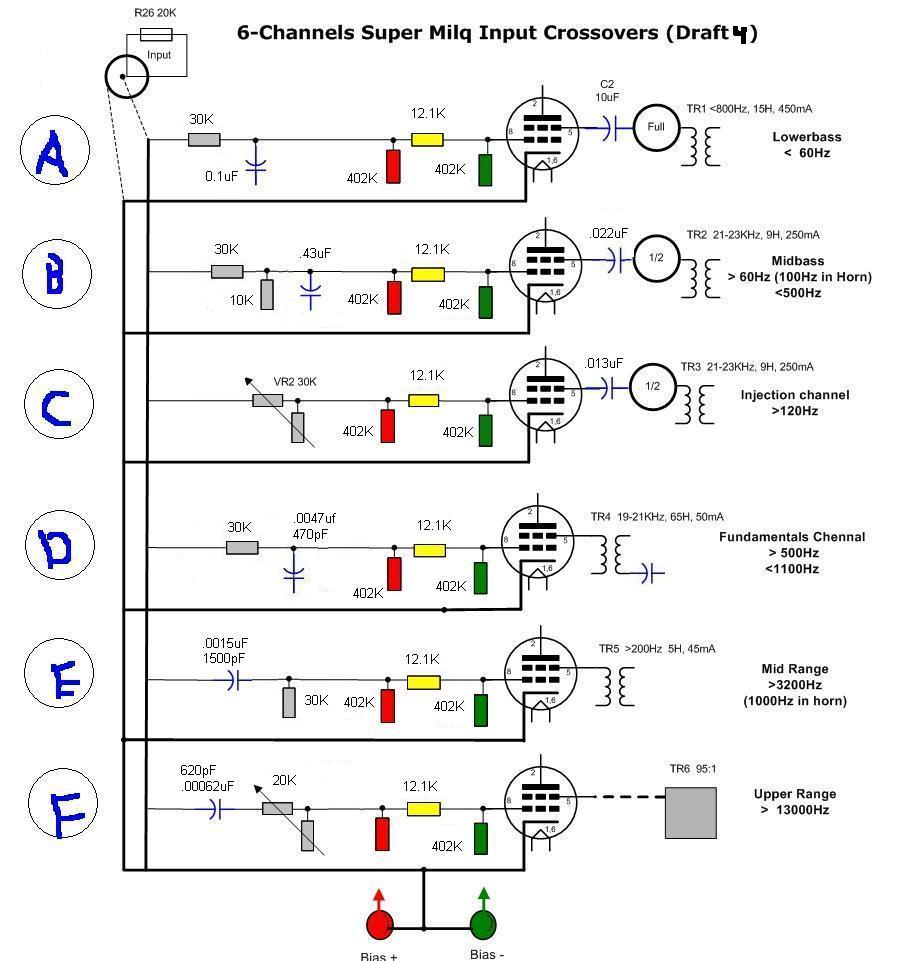
|
|
|
|
Posted by cv on
08-31-2007
|
Romy,
Are you currently implementing "nominal" 3200Hz x/o on the mid range channel S2 using a cap at the driver? I know this works nicely to ameliorate the "secondary" resonance of the plastic edged diaphragm.
Reason I ask is because things may not work quite the same with the scheme above - some of the response shaping of the 3.9uF (or whatever it was) cap at speaker level may be due to an interaction with the S2 inductance etc, which you wouldn't get if the S2 were a textbook resistive load (as seen by the 1500pF cap in the 6 ch Melq).
cheers
|
|
|
|
Posted by Romy the Cat on
08-31-2007
|
 cv wrote: cv wrote: | Romy,
Are you currently implementing "nominal" 3200Hz x/o on the mid range channel S2 using a cap at the driver? I know this works nicely to ameliorate the "secondary" resonance of the plastic edged diaphragm.
Reason I ask is because things may not work quite the same with the scheme above - some of the response shaping of the 3.9uF (or whatever it was) cap at speaker level may be due to an interaction with the S2 inductance etc, which you wouldn't get if the S2 were a textbook resistive load (as seen by the 1500pF cap in the 6 ch Melq). |
|
Yes, I know and consider it, it would not be difficult to tune the cap to se the S2 to response properly. However, there is a bigger fish to fry in here. If you remember in my 3 channel Super Mils I was not able to use line level high-path between the stages in my HF chennal as it sounded very wrong. I still have no explanation why. I just hope that it will not happen with the single-stage amp.
|
|
|
|
Posted by Romy the Cat on
09-01-2007
|
|
OK, I’m getting somewhere. This thins bee quite heavy and quite uncomfortable to handle by heands… Still, it far from end....
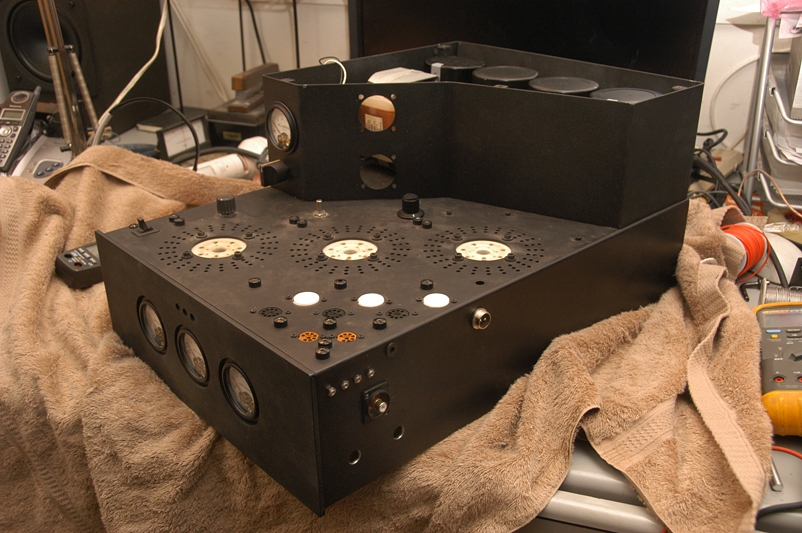
|
|
|
|
Posted by cv on
09-01-2007
|
...yes, I remember. I wonder if it's due to the large (and varying with signal) capacitance of the 6C33 input interacting with the small coupling cap. Hopefully this will be less of an issue with the 6e5p/6p.
cv
|
|
|
|
Posted by Romy the Cat on
09-01-2007
|
 cv wrote: cv wrote: | | ...yes, I remember. I wonder if it's due to the large (and varying with signal) capacitance of the 6C33 input interacting with the small coupling cap. Hopefully this will be less of an issue with the 6e5p/6p. |
|
Chris,
It is certainly a factor but I relay do not know is this factor has a direct relativity to the worsening of the sound that I experienced. I have written somewhere that I did dropped the value of the bias resistor on 6C33 and increased the compiling capacitor value but it had no effect. Eventually I figured out that can’t go lover then .8uF in there… which is VERY far form own capasitanse of the 6C33…
In case of the single stage amps I do not know what will happen. The tube (of much lover Miller capacitance) is further up but the values I use are in the filter 630pF and 1500pF are very small, though I less care bout the HF channel at this metter. Sine I have tremendous driving ability in my preamp with 8R output impedance I might consider drooping input impedance of my MF channel (E channel) and increase the capacitor values in the high-path filter. If it does not work I can always go with a cap at speaker level. The Cat
|
|
|
|
Posted by Romy the Cat on
09-02-2007
|
|
The new Super Milq’s input with combined filer and bias resistors.

|
|
|
|
Posted by Paul S on
09-03-2007
|
Pretty clean, Romy (and one hellova tranny at Fundamentals)!
Of course, I have questions:
I thought you said Vishay metal foils in your earlier response about bias adjustment?
If so does that mean steps, or... how, exactly?
When you specify "Full" or "1/2" at LF, MLF and injection speaker level do you mean another cap in series that is either a repeat or 1/2 of the cap value that is called, for the lower total capacitance?
Also, will these caps in series straddle the hot end of a resistor or variable resistance run across the poles in your "active" arrangement?
I still aim to try it myself, on your recommendation, but I have to admit I do not understand how this works, and I ass-u-me that you still have to "increase" the value of each of the two caps in series to arrive at the desired working value, resistor notwithstanding?
Pushing my luck, are you trimming gain to the ribbon at line level with only simple resistance/shunt?
Does Alex's attenuator figure in to this?
Going for gold, where does EQ happen at injection channel?
Sorry, but it's not only too hot for listening, it's too hot to sleep!
Best regards,
Paul S
|
|
|
|
Posted by Romy the Cat on
09-03-2007
|
 Paul S wrote: Paul S wrote: | | Pretty clean, Romy (and one hellova tranny at Fundamentals)! |
|
50mA, 60H, LL1623 Amorphous
 Paul S wrote: Paul S wrote: | | I thought you said Vishay metal foils in your earlier response about bias adjustment?
If so does that mean steps, or... how, exactly? |
|
The Vishay metal foils are not stepped attenuators but regular trimmers. At this point I decided do not go for them and to use regular Bourns cerment trimmers.
 Paul S wrote: Paul S wrote: | | When you specify "Full" or "1/2" at LF, MLF and injection speaker level do you mean another cap in series that is either a repeat or 1/2 of the cap value that is called, for the lower total capacitance? |
|
Nope, I meant a full 6C33C vs. the 6C33C with one anode.
 Paul S wrote: Paul S wrote: | | Also, will these caps in series straddle the hot end of a resistor or variable resistance run across the poles in your "active" arrangement?
I still aim to try it myself, on your recommendation, but I have to admit I do not understand how this works, and I ass-u-me that you still have to "increase" the value of each of the two caps in series to arrive at the desired working value, resistor notwithstanding? |
|
I’m sorry I do not understand it….
 Paul S wrote: Paul S wrote: | | Pushing my luck, are you trimming gain to the ribbon at line level with only simple resistance/shunt? |
|
It is not a shunt. The high-pass filter woks ageists this attenuator and therefore it could not be a shunt. I use a laden-type 24 step with “fixed” input impedance.
 Paul S wrote: Paul S wrote: | | Does Alex's attenuator figure in to this? |
|
I do not know what it mean…
 Paul S wrote: Paul S wrote: | | Going for gold, where does EQ happen at injection channel? |
|
The .013uP between the stages will do ~100Hz. I'm not sure if I will stay with this solution.
|
|
|
|
Posted by Paul S on
09-03-2007
|
Just 1 attempt to explain dumb questions, then a sleeping pill:
OK, mistook the interstage couplers for speaker level caps, as though all channels were single stage, and from there projected the "active" band pass at speaker level (wrong turn at a high rate of speed...).
I thought you said Alex made a special attenuator for your Water Drop (back in WD thread), and I do not understand its principles or interface with what is shown.
Hell, I use cement R in crossovers...
Best,
Paul
|
|
|
|
Posted by Romy the Cat on
09-03-2007
|
|
The first time the new amp is semi-operational. Still it is a loooooong way to go… to tune, to measure and to calibrate everything….
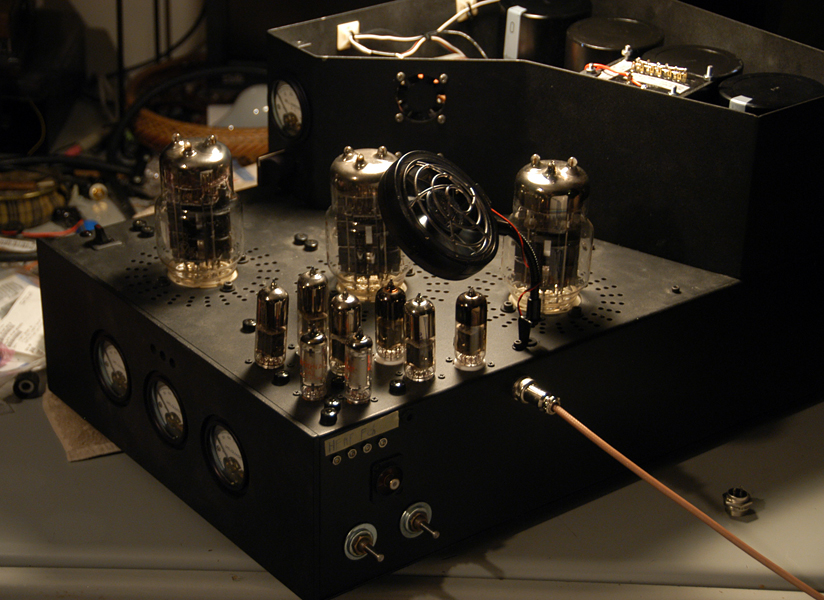
|
|
|
|
Posted by Romy the Cat on
09-04-2007
|
|
I turned the thing on lately. Although the channels do not sound right at this point but there are some moments that I do live very much. I like the mechanical noise that this version of Milq radiates.
The former version had still chassis on PS side and too many peaces or magnetics that were talking with each other via the chassis and stay fields. The new Milq has toroidal filament transformer 10A on 6.3V and 10A on 12.6V and toroidal chokes. Furthermore, all of them are in sealed cans and all of then elevated from the chassis. Also, I have found new type of fans and different ways to mount them…. All of it made the new Super Milq very silent. In fact it is so silent now, that if disregard the light emitted from the tubes and meters then it is not noticeable if the amps is on or off – very good, particularly taking under consideration the currents that flow in the amp…. Rgs, Romy the Cat
|
|
|
|
Posted by Romy the Cat on
09-04-2007
|
Ok, now it looks like the amp is operational. I was listing today the individual channels (without tweeter – the 175:1 transformer is coming). The channels do sound very promising… here are some sweeps with the filter on. All channels use well warns test tube, so I case less about the gain.
The bass channel, it looks pretty good as is
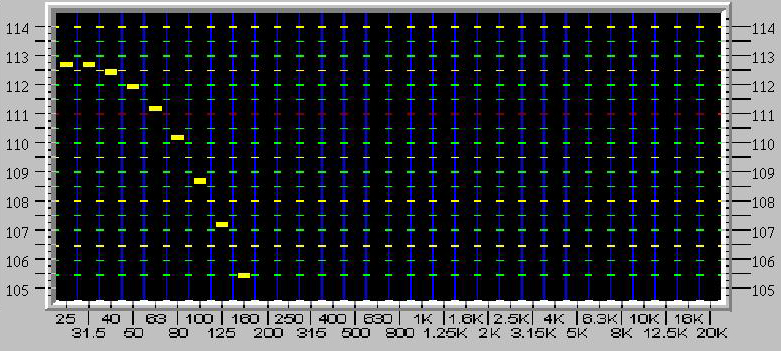
The upperbass, it looks like the attention in the input voltage deviser was right and the response is almost where it should be, I might opened it up at upper knee..
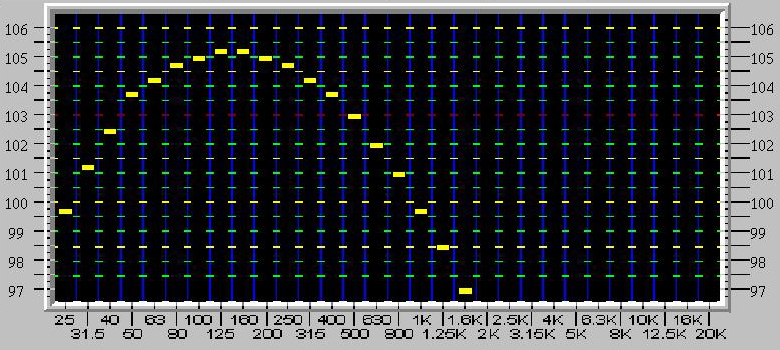
The Fundamental channel. I will high pass it at speaker level as it is just one stage and there is no room to write another filter. I need to listen it and to find out how high I will take it. Preliminary I shell I might take it one octave higher…
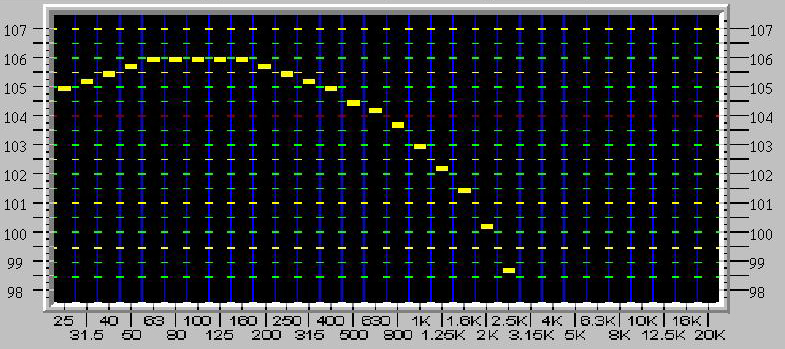
The MF – it looks fine.

The Injection channel. There is a mystery dive for ½ dB in the mid range and the HF are rolling off too soon. Something is not kosher in there... However, the general high pass is fine.
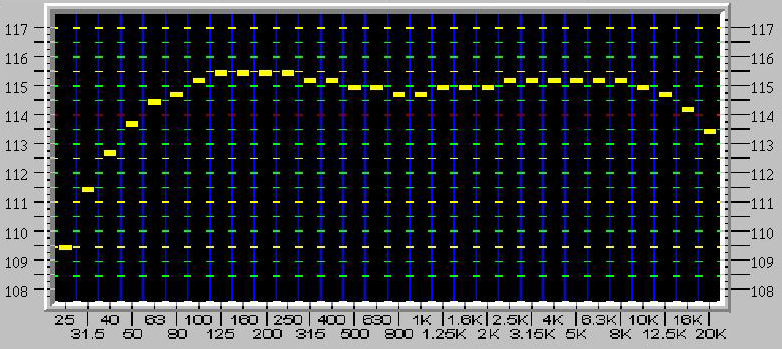
|
|
|
|
Posted by Romy the Cat on
09-05-2007
|
I was kind of frustrated with some strange high frequency roll off at my HF and Injection channels. It should not happen. The 9H OPT LL1627 in Injection channels should be good up to 23kHz according to my former tests with a full range Milq and the Tribute’s OPT with 4H primary and limited amount of turns should be much more extended into HF.
So, I figures that I might be my TRA lied at HF – I did not celibate it before I measured it. So, I run it into the scope and it looked very good exactly - how I expected. Take a look – it is 3V driven into the Milq and the signal was taken from HF channel.
The first one is the calibration of the amplitude at 10 kHz where the channel is a complete band-pass. I made it 10 squares.
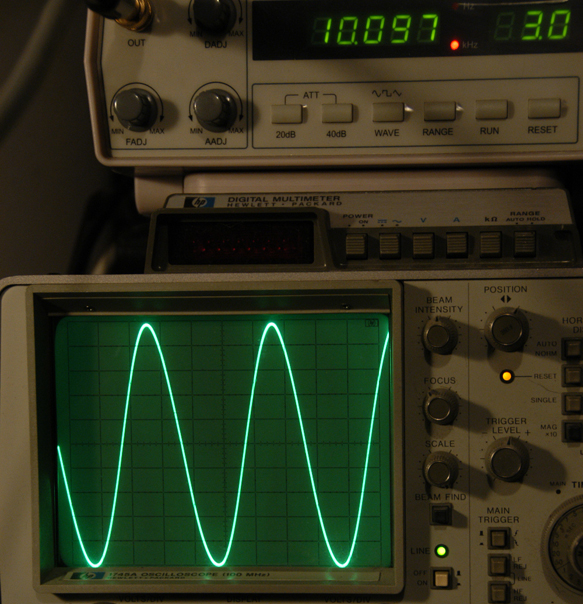
Now let to slide the frequency and see where the high-pass crossover will kick in. 3dB in my case is 3 squares or 1.5 squares from top and from bottom. So, I have minus 3dB around 2750Hz.
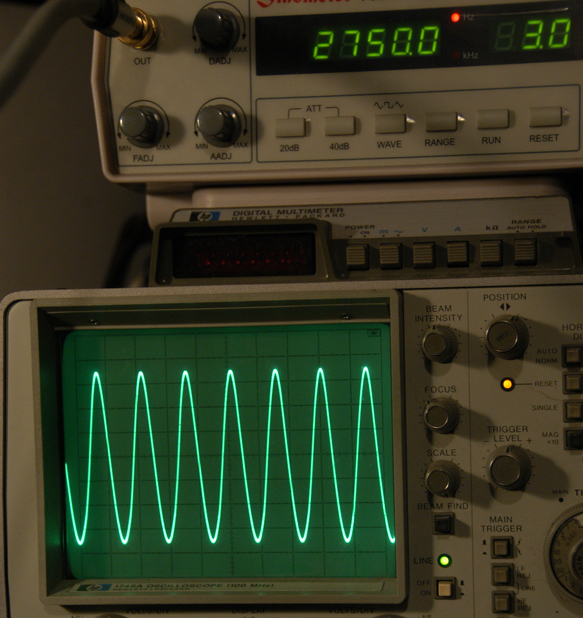
Let now to raise the frequency. The 20kHz – it has no impact to amplitude and the channel handles it at 0dB…
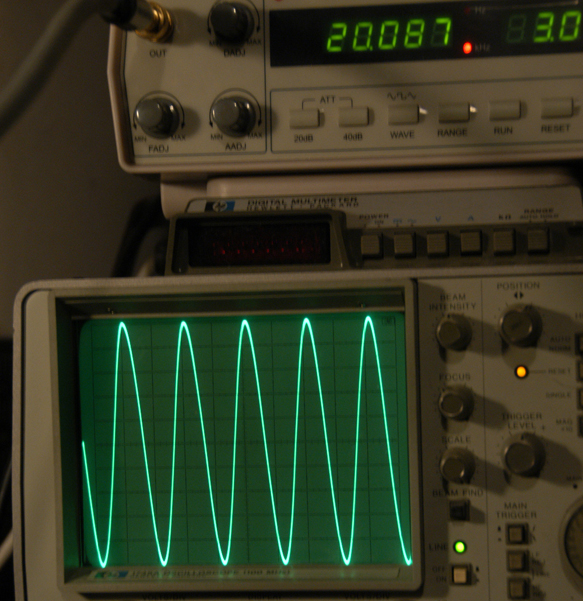
Now let to move up frequency until I get the 1.5 squares (3dB) roll off. I happened at 75 kHz – not bad at all… In hardly need it for Vitavox S2 driver but still…
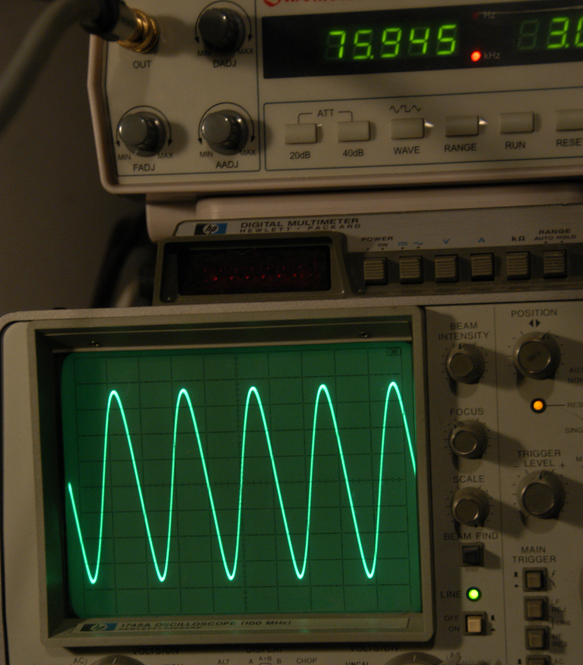
It was my MF channel - I did not test my HF as I have no transformer yet – it is coming. It will be driving the Water Drop ribbon directly form the 6E5P’s plate. It is Amorphous torpid 175:1, turn to foil with primary inductance 180mH, leakage inductance 1.7mH and capacitance between primary and secondary .062nF. It should be fun to listen THAT high frequency
Rgs, Romy the Cat
|
|
|
|
Posted by Romy the Cat on
09-06-2007
|
|
Jessie was very right talking about therapeutic influence of audio projects.
I do not know why buy I feel very much attached and really feel personally the various micro events that I are going on with my current 6-channel Supper Milq project. The idea of a parallel narrow-bandwidth operation is very intuitive and lucrative, the design and layout happened to be very elegant and it is very tangible pleasure to make it happen, at least it is that way how I feel. I am being a consultant and paid for hours even took time off another day in order to go home and to implement and to try on the Super Milq the ideas that suddenly came into my mind – a very dangers symptom indeed…
Anyhow, today is the big day and I am planning to load 5 Super Milqs channels to Macondo and will try to listen it…. It should be interesting…. The Cat
|
|
|
|
Posted by Paul S on
09-06-2007
|
I think this is one of the reasons that some DIYers get so far out there. I look back on my early days and laugh, with the modded Rek-O-Kuts, Altecs, etc., but tend to take myself a little more seriously in the here-and-now (...that's different...).
The design sure looks good on paper, and it feels right, too, except I have had doubts all along about a single stage doing enough of what you want, based of course on never having heard anything like what you are attempting.
A key for me is to call it quits before I get manic and/or exhausted, no matter how close to completion I think I am at the time [I get tired]. Most of my serious errors have occurred when I am pushing myself, often in the heat of expectation.
Not saying you would ever get tunnel vision...
I'm rooting for you (and archiving your hard work).
Best,
Paul S
|
|
|
|
Posted by Romy the Cat on
09-07-2007
|
An “attachment” and self-enslaving feeling that I hardly feel in anything and defenatly do not exercise any attachment in audio. The DIYers do not “get so far out there” they are “there” to begin with - nowhere. I do not just hate all that DIY-movement but I even hate the DIY word as it implies a stupid preoccupation with the processes of making audio instead of recognition of results. The people who feel an attachment in direct proportion to efforts should think again about rational of their sensations.
Rgs, Romy the Cat
|
|